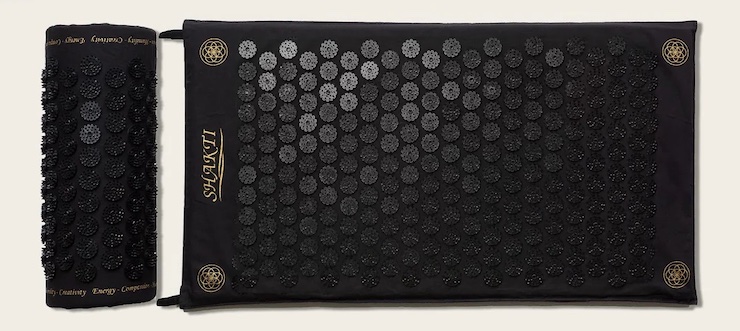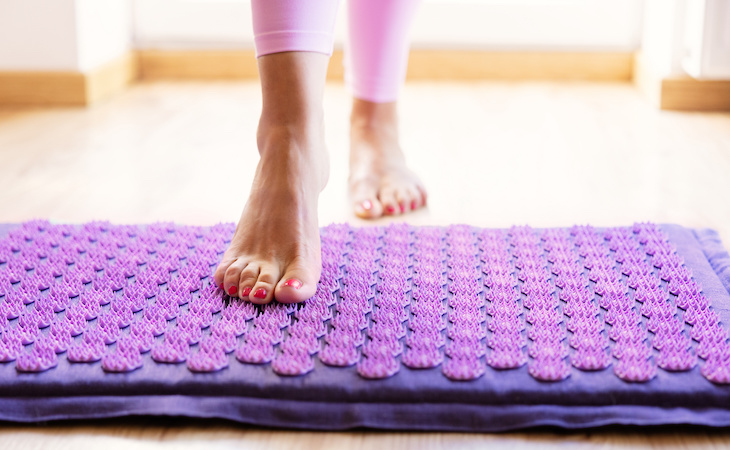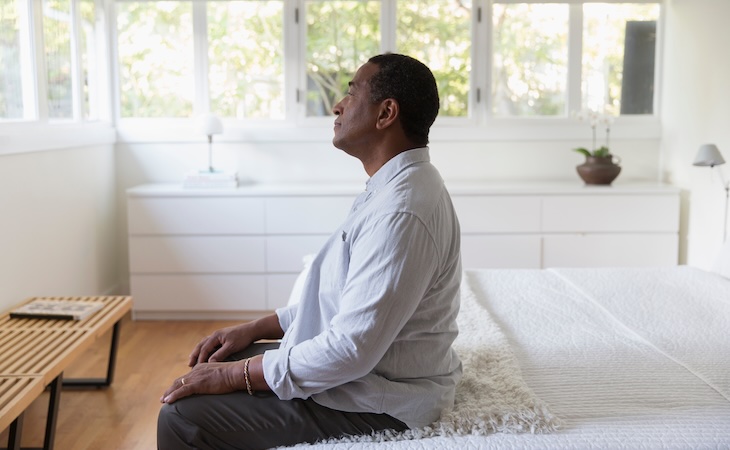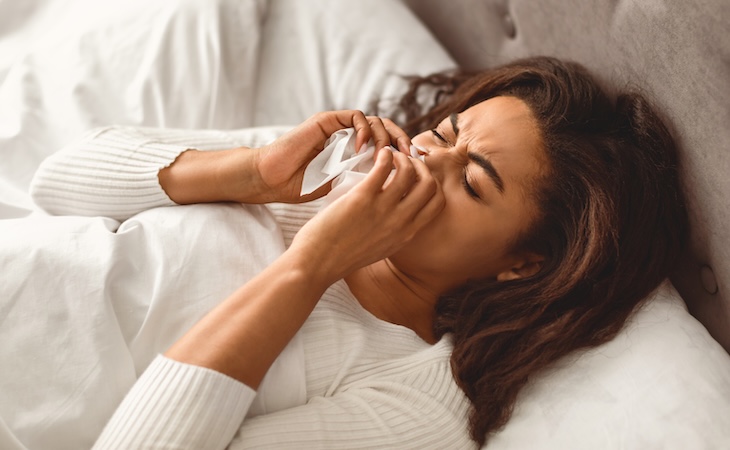When it comes to bedtime, I really struggle with the transition from “awake” to “asleep.” Even if my body is tired, my mind has a tendency to race as soon as my head hits the pillow—which can lead to hours of tossing and turning before I finally drift into dreamland.
As such, I’m always looking for tools and strategies that will help me unwind—and put my brain and body in a position where they’re ready to fall asleep shortly after I get into bed.
One tool that I’ve recently found and decided to explore? Acupressure mats.
Devotees claim that acupressure mats offer a variety of health benefits—including better sleep. But do they actually work?
Let’s take a look at everything you need to know about acupressure mats, including what they are, how they work, and their purported benefits—as well as my first-hand experience trying an acupressure mat for better sleep.
What is an acupressure mat?
An acupressure mat is a mat that’s covered in small plastic spikes. These spikes are strategically placed to stimulate and apply pressure to specific points throughout the body—which can, depending on how you position yourself on the mat, cause different reactions in the body.
Unlike acupuncture (which uses needles that penetrate the skin), the plastic spikes on an acupressure mat will apply pressure—but will never puncture the skin.
An acupressure mat is a mat that’s covered in small plastic spikes. These spikes are strategically placed to stimulate and apply pressure to specific points throughout the body—which can, depending on how you position yourself on the mat, cause different reactions in the body.
How do acupressure mats work?
Now that you know what an acupressure mat is, let’s touch on how it works.
“Acupressure mats work by stimulating pressure points across your body,” says Theodore Levarda, licensed acupuncturist at Morningside Acupuncture in New York City.
According to Chinese medicine, stimulating these pressure points plays a key role in moving “qi” (which means “life energy”) through the body—which is essential to maintaining optimal health.
Looking at acupressure through a Western medicine lens, “The pressure from the mat helps to activate the body’s parasympathetic nervous system, which is responsible for promoting relaxation and reducing the body’s stress response,” says Levarda. “[From a sleep perspective], this can make it easier to fall asleep and stay asleep through the night.”
Acupressure mat benefits
You know what an acupressure mat is. You know how it works. So, what are the purported benefits of using an acupressure mat—and, more specifically, using it as part of a sleep routine?
Increased relaxation
According to Levarda, acupressure mats “can help to calm down the nervous system, relax muscles, [and] reduce stress.”
Or, in other words, these maps can help you access a deeper state of relaxation—which may help you improve the quality and quantity of your sleep.
Decreased pain
Studies have found that acupressure tools (like acupressure mats) may help to decrease and/or make different types of pain more manageable, including dental pain, menstrual pain, and neck and back pain.
For people who live with pain that makes it hard to sleep, acupressure mats may be able to help them better manage their pain—and get better sleep in the process.
Better blood circulation
Acupressure mats may also “promote better blood circulation,” says Levarda. This can help alleviate symptoms of poor circulation like numbness or weakness in the limbs as well as support a variety of systems in the body, including organ function, mental clarity, and heart health.
Risks of acupressure mats
While acupressure mats are generally considered safe, certain people shouldn’t use these mats. This includes people with thin and/or sensitive skin, people with diabetes, or people who are or may be pregnant.
How to use an acupressure mat
Now that you know the ins and outs of acupressure mats, the next question is: How do you use them?
To use an acupressure mat, you’ll first need to lay it on the ground. Then, lie down on the mat, ensuring it makes contact with your back, shoulders, and neck, says Levarda.
Now, if it feels a little uncomfortable, don’t panic. “Some users might feel slight discomfort initially, but this usually subsides after a few minutes as the body adjusts to the pressure,” says Levarda.
If you find the sensation to be too intense, try wearing a shirt, which will act as a barrier between the spike and your skin (versus putting your skin directly on the mat). Then, as you get more comfortable, you can opt for direct skin contact.
Next, let’s answer another important question: How long should you lie on an acupressure mat? When it comes to time spent on the acupressure mat, less is more—particularly at first.
“Start slowly and increase your time on the mat,” says Levarda. This will allow you to “gradually build tolerance and maximize the benefits for better sleep,” she explains.
If you’re brand new to the world of acupressure, try using the mat for 10 to 20 minutes before bedtime, suggests Levarda.
As you build your tolerance, you can slowly extend your time until you find that “sweet spot” that delivers the experience and results you’re looking for.

Do acupressure mats work? My review
As mentioned, I recently decided to try an acupressure mat to see if it would help me fall (and stay!) asleep. I bought the Shakti Essentials Bundle, which includes both a Shakti Acupressure Mat (which is focused more on the back) and Shakti Acupressure Pillow (which targets the head, neck, and shoulders).
When I first unpacked the box, I was a little apprehensive. Those spikes looked sharp! But, as I said earlier, I’m willing to try pretty much anything to get better sleep—and so I put on a thin T-shirt, laid on the mat, and rested my neck and head on the pillow.
My initial reaction was one of discomfort. But as I settled in and breathed through the discomfort, I found myself relaxing into the experience.
I could feel the tension in my body—particularly my shoulders, which is where I carry all my stress—start to unwind a bit. I actually found myself liking the experience. I made it about 10 minutes—and then headed to bed less than an hour later, where I was able to fall asleep somewhat quickly.
I now use the acupressure mat once or twice per week. Is it a magic bullet that’s allowing me to fall asleep as soon as my head hits the pillow? No. But do I think it’s helping me relax—and, as such, helping me fall asleep more easily? I do.
I see it as another tool in my arsenal—something that I can add to my pre-bedtime routine to help me get myself to a place where I both want to and can fall asleep.
I could feel the tension in my body—particularly my shoulders, which is where I carry all my stress—start to unwind a bit. I actually found myself liking the experience. I made it about 10 minutes—and then headed to bed less than an hour later, where I was able to fall asleep somewhat quickly.
FAQs
Do acupressure mats actually work?
While there isn’t a huge amount of research, studies suggest that acupressure mats may be able to help promote relaxation and decrease pain—both of which can help support better sleep.
How often should you use an acupressure mat?
When it comes to how often to use the acupressure mat, consistency is key, says Levarda. “Use the acupressure mat regularly to experience its full benefits,” she says.
Can breathing necklaces improve your sleep? Next, learn all about the sleep and health benefits of breathing necklaces.




